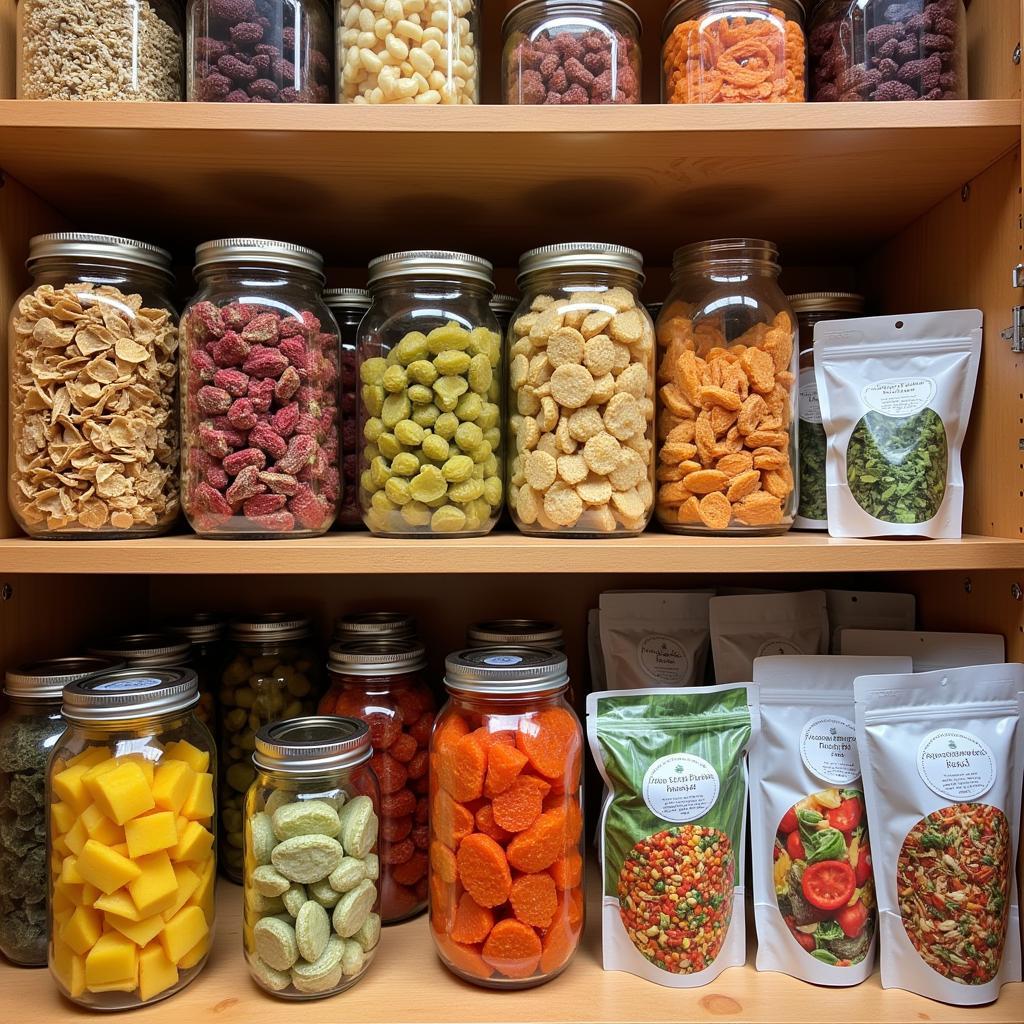When it comes to preserving food, dehydration and freeze drying are two popular methods that offer long shelf life and convenient storage. But what exactly are they, and how do they differ? This comprehensive guide delves into the battle of Dehydrated Vs Freeze Dried Food, exploring their processes, benefits, drawbacks, and ideal use cases to help you make informed decisions for your pantry.
Understanding Dehydration: A Time-Tested Preservation Technique
 Dehydrated Fruits and Vegetables
Dehydrated Fruits and Vegetables
Dehydration, simply put, is the process of removing moisture from food to prevent spoilage. This age-old technique dates back centuries, with our ancestors harnessing the power of the sun and wind to dry fruits, vegetables, and meats.
How Dehydration Works:
Today, dehydrators make the process more efficient, utilizing controlled heat (typically between 130-160°F) and air circulation to evaporate water content. As the moisture evaporates, the food shrinks in size and becomes more concentrated in flavor and nutrients.
Benefits of Dehydrated Foods:
- Extended Shelf Life: Dehydrated foods can last for months or even years when stored properly in airtight containers.
- Lightweight and Compact: The removal of water significantly reduces the weight and volume of food, making them ideal for backpacking, camping, or emergency food supplies.
- Nutrient Retention: While some vitamins may be lost during the process, many nutrients, including fiber, minerals, and antioxidants, remain largely intact.
- Cost-Effective: Dehydrators are relatively affordable, and you can even dry food at home using an oven or a solar dehydrator.
Drawbacks of Dehydrated Foods:
- Texture Changes: Dehydrated foods often have a chewier or leathery texture, which may not be appealing to everyone.
- Longer Rehydration Time: Compared to freeze-dried food, dehydrated items typically require a longer soaking time to reconstitute.
- Potential Nutrient Loss: Some heat-sensitive vitamins, like vitamin C, may degrade during the dehydration process.
Unveiling Freeze Drying: The Future of Food Preservation?
Freeze drying, also known as lyophilization, takes preservation to a whole new level. This sophisticated method removes moisture from food while frozen, resulting in superior quality and minimal nutrient loss.
The Science Behind Freeze Drying:
The process involves three key steps: freezing, primary drying (sublimation), and secondary drying. During sublimation, the ice crystals in the frozen food transition directly into vapor without passing through a liquid phase, leaving behind a dry and porous structure.
Advantages of Freeze-Dried Foods:
- Exceptional Quality: Freeze drying preserves the taste, aroma, color, and nutritional value of food to a remarkable extent.
- Fast Rehydration: Freeze-dried foods rehydrate rapidly due to their porous structure, often regaining their original texture and appearance.
- Long Shelf Life: When stored correctly, freeze-dried foods can last for an impressive 25-30 years, making them a reliable option for long-term food storage.
- Minimal Nutrient Loss: Since freeze drying occurs at low temperatures, it minimizes nutrient degradation, preserving a higher percentage of vitamins and antioxidants.
Disadvantages of Freeze-Dried Foods:
- Higher Cost: Freeze drying is a more complex and energy-intensive process, making freeze-dried foods significantly more expensive than dehydrated options.
- Specialized Equipment: Freeze drying requires specialized equipment, making it challenging and costly to freeze dry food at home.
- Fragility: Freeze-dried foods are delicate and can easily crumble, necessitating careful handling and packaging.
Dehydrated vs Freeze Dried Food: Which One Wins?
The choice between dehydrated and freeze-dried food ultimately depends on your specific needs and priorities.
When to Choose Dehydrated Foods:
- Budget-Friendly Option: If cost is a primary concern, dehydrated foods offer an affordable alternative for long-term food storage.
- Space-Saving Solution: Their compact size makes them ideal for backpacking, camping trips, and emergency preparedness kits.
- Suitable for Specific Foods: Dehydration works particularly well for fruits, vegetables, jerky, and herbs.
When to Choose Freeze-Dried Foods:
- Uncompromising Quality: If you prioritize preserving the taste, texture, and nutritional value of food, freeze drying is the superior choice.
- Quick and Easy Preparation: The rapid rehydration time of freeze-dried foods makes them convenient for everyday meals and snacks.
- Long-Term Food Storage: For emergency preparedness and building a resilient pantry, freeze-dried foods offer exceptional longevity.
- Specialized Dietary Needs: Individuals with dietary restrictions or allergies may find freeze-dried meals and ingredients more readily available.
Making Informed Choices for Your Pantry
 Pantry with Dehydrated and Freeze-Dried Foods
Pantry with Dehydrated and Freeze-Dried Foods
Understanding the differences between dehydrated vs freeze dried food empowers you to make the best choices for your pantry. Whether you’re a seasoned hiker seeking lightweight trail snacks or a health-conscious individual looking to incorporate nutrient-rich options into your diet, both dehydration and freeze drying offer unique advantages.
Need help deciding which type of food is right for you? Reach out to our team at Phone Number: 02437655121, Email: minacones@gmail.com. Or visit us at 3PGH+8R9, ĐT70A, thôn Trung, Bắc Từ Liêm, Hà Nội, Việt Nam. We’re here to assist you 24/7.